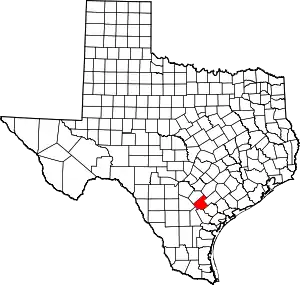| Texan Silesian | |
|---|---|
| Teksasko gwara | |
| Native to | United States |
| Region | Panna Maria, Texas |
| Ethnicity | Silesian Americans in Texas |
Native speakers | less than 96 (in 2000)[1] |
| Language codes | |
| ISO 639-3 | None (mis) |
| Glottolog | sile1253 |
| Linguasphere | |
| IETF | szl-u-sd-ustx |


Texan Silesian[lower-alpha 1] is a dialect of the Silesian language used by descendants of immigrant Silesian Poles in American settlements from 1852[1] to the present. The speakers of the dialect came to America from the area of Płużnica Wielka, Strzelce Opolskie and Toszek in Opolian Silesia.[2] The dialect evolved around the area of the unincorporated community of Panna Maria in Karnes County, Texas[3] which is considered by the Texas State Historical Association "the oldest permanent Polish settlement in America and as the home of the nation's oldest Polish church and school."[1][4] Another significant settlement in which Texan Silesian is present is neighboring Cestohowa.
Texan Silesian is substantially less influenced by German because its speakers emigrated before the Kulturkampf, a government campaign of Germanization enacted by the German Empire, which added many Germanisms to the Silesian dialect within said country's pre-1914 state borders.[5] The language is kept alive by its current speakers, but they know it only in its spoken form.[5] Texan Silesian has not been replaced by English as a spoken language by the older generations of the Panna Maria area, because the local Silesian Polish community was historically strongly isolated. Nevertheless, Texan Silesian has adopted some words from English.
One of the characteristic features of Texan Silesian phonetics is called mazuration, a widespread linguistic process within Polish language, especially extant in rular areas, in which postalveolar fricatives and affricates (Polish cz, sz, ż, dż) are pronounced [t͡s, s, z, d͡z], whereas in the Silesian dialect of the Katowice urban area they are pronounced [t͡ʂ, ʂ, ʐ, d͡ʐ]. Mazuration was already present in Texan Silesian. Another phonetic peculiarity of the dialect is its more recent denasalization. For example, the nasal vowel [ɛ̃], still common in modern Polish and present in Texan Silesian of the 19th century, became the oral vowel [ɛ] or diphone [an], differing from most other Silesian dialects, in which denasalization of [ɛ̃] produced the diphone [ɨn]. This might suggest that Texan Silesian split from other Silesian dialects before the denasalization process began. A visible product of these language changes is the name of the settlement of Cestohowa. Its name is derived from Częstochowa, a city of large religious importance within Poland, but, due to the phonetic processes mentioned above, cz was written as c, while ę was written as e.[2]
Typical words unlike Silesian in Poland
| Texas Silesian | Silesian | English |
|---|---|---|
| turbacyjŏ[2] | niyprzileżytość | problem |
| zaszanować[2] | zaszporować | to save money |
| kapudrok[2] | zalōnik | frock coat |
| furgocz[5] | fliger | aeroplane |
| szczyrkowa[2] | szczyrkowa (loanword from Texas Silesian) | rattlesnake |
| po warszawsku[2] | po polsku, po polskimu | in Polish |
| prastarzik[2] | starzik, ôpa | great-grandfather |
| cieżko[2] | fest, fes, fys | very |
| kole tego[6] | ô tym, koly tego | about that |
| pokłoud[5] | gipsdeka | ceiling |
| bejbik[7] | bajtel | baby |
| kara[7] | auto | car |
| wiater[7] | luft | air |
| korn | kukurzica | corn |
| farmiyrz | gospodŏrz | farmer |
| plōmzy, piczesy | fyrzichy | peaches |
| garce | buncloki, garki, gorce | pots |
Notes
- ↑
- Silesian:
- Steuer's Silesian alphabet: teksasko gwara,
- Silesian primer alphabet: teksaskŏ gwara,
- literally: Texan subdialect
- Standard Polish: gwara teksaska
- Silesian:
References
- 1 2 3 "TSHA | Panna Maria, TX".
- 1 2 3 4 5 6 7 8 9 "RADIO COURIER". Archived from the original on 3 November 2007. Retrieved 5 March 2015.
- ↑ "Telewizja TVS". Retrieved 5 March 2015.
- ↑ Texas State Historical Association. "Moczygemba, Leopold". Texas State Historical Association. Retrieved 2023-08-07.
- 1 2 3 4 "U nas jest inna Ameryka". Archived from the original on 2009-12-21. Retrieved 2009-01-27.
- ↑ "ŚLŮNSKO EKA - Ze gyšychty našyj godki". Archived from the original on 6 March 2008. Retrieved 5 March 2015.
- 1 2 3 "Inne". katowice. Retrieved 5 March 2015.